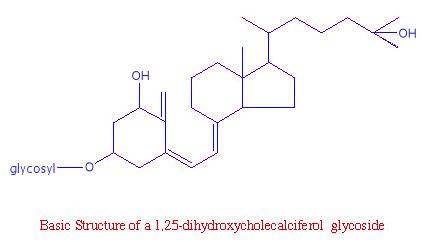Calcinogenic Glycosides
Certain plants contain glycosides of the active metabolite of vitamin D. The metabolite is called 1,25-dihydroxycholecalciferol or more simply 1,25-OHD3. Consumption of glycosides of 1,25-OHD3 by grazing animals leads to a vitamin D toxicity which causes the deposition of excessive calcium in the soft tissues (calcinosis). Of the three rangeland plants, Cestrum diurnum , Solanum malacoxylon , and Trisetum flavescens , known to contain these glycosides only Cestrum diurnum is found in the U.S. primarily in Florida.

[How poisoning occurs] [Symptoms of poisoning] [Return to list of toxicants]
Vitamin D functions to regulate calcium and phosporus absorption. Its metabolite, 1,25-OHD3, controls the synthesis and functions of calcium-binding proteins in the intestinal mucosa transporting calcium after digestion from the intestines to the blood stream. Animals synthesize their own 1,25-OHD3 through a feedback system in which low (high) serum calcium levels trigger increased (decreased) parathyroid hormone secretion which in turn triggers the production of more (less) 1,25-OHD3 leading to increased (decreased) absorption of calcium into the blood. This feedback system is disrupted by the consumption of external sources of 1,25-OHD3 which are not sensitve to already existing serum calcium levels. This excess 1,25-OHD3 causes elevated serum calcium levels leading to a condition known as calcinosis in which the extra calcium is deposited on the animal's soft tissues.
A kilogram of dried Cestrum diurnum leaves yields approximately 3 * 103 IU D3. If Cestrum diurnum makes up 15 to 30% of the animal's diet, this may be sufficient to cause calcinosis. Symptoms in animals grazing toxic levels of Cestrum diurnum are:
- progressive weight loss,
- lameness and stiffness,
- arched backs,
- hypercalcemia,
- hyperphosphatemia, and
- calcification of the tendons, ligaments, lungs, diaphragm, kidney, and cardiovascular system.